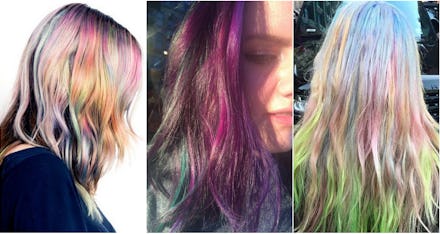Meet the Woman Behind All the Viral Hair Trends You See on Instagram

If you've lusted after the "opal hair" trend or the "oil slick" hair color look, you can thank Aura Friedman.
Friedman is a hair color expert and hairstylist at Sally Hershberger Salon in New York City, and her career long predates Instagram. She's been in the business for over 20 years, lending her hair coloring skills to clients ranging from Lady Gaga to Anna Paquin, as well as the pages of fashion magazines and runways.
But these days, Friedman's Instagram account has brought her work far beyond salons and celebs.
Like other celebrity hairstylists, like Jenny Cho and Mark Townsend, Friedman has a large following on Instagram these days, reaching nearly 30,000. Since she got into the Insta game, she's been snapping pics of her clients, famous and not. And the snapshots of the colorful creations atop her clients' heads have a tendency to go viral, some even sparking trends of their own.
So Mic talked to Friedman to get the lowdown on what we're really seeing all over Instagram.
How an Instagram photo becomes a trend: Manic Panic has been around since 1977. But the latest wave of hair color mania, if you will, has been prevalent for about the past four years, since model Charlotte Free made a splash with her pink locks and celebrities started jumping aboard. In 2011, the New York Times declared that once shocking colorful hairstyles had become practically conservative.
That's right about the time Instagram came into our lives, and the hair colorists have found ever-growing audiences since. Plenty of online hair trends are only requested by people within the fashion and entertainment industries, with the more wild colors not making it to "regular" people. But some do — and for colorists, that's part of the fun, Friedman told Mic.
It can be as simple as one beauty editor or blogger seeing a colorist post a trend on Instagram or Tumblr, Friedman said. When one influencer writes about or tries the trend, others are likely to follow suit.
Now, Friedman herself is one of those influencers. When Friedman tried the oil slick method, for example, she Instagrammed photos of the look with the hashtag #oilslickhair, and within a matter of weeks, plenty of digital outlets were covering the trend. (Hashtags help make something a Thing.)
Clients still ask for some of Friedman's creations years after she's created them, such as the "splashlight" effect, which includes lightening a horizontal portion of hair to mimic the effect of a spotlight; while other trends have remained more niche.
How Friedman comes up with her creations: As for how the splashlight effect or oil slick hair came to be, it should be a lesson to us all: Creating hair color trends isn't planned, said Friedman, but comes from working with clients to create looks that match their personalities, while taking inspiration from everything from '60s movies to gemstones.
"I don't start out [creating a new hair color] as a trend," Friedman said. "I just do it because I'm into it at the moment."
For the opal hair trend, Friedman considered her own birthstone and the way it reflects light. "I'd always wanted to play around with the idea of recreating a somewhat iridescent look," she explained. Friedman translated her fascination with pearlescent qualities into a rainbow of pale shades on pale hair.
Friedman's inspiration for the oil slick look, meanwhile, is a look close to what its name suggests — a collection of darker, colorful hues reminiscent of the shades seen in an oil puddle on the street. As opposed to many of the colorful trends, which look best on light hair, oil slick is ideal for brunettes.
Not all trends are created equal: It's easy to be overwhelmed with the endless hair-color trends, but Friedman stressed not every wild look works for every person. Above all, women should take into consideration the amount of maintenance colorful looks require.
"Pastel hair color does take more maintenance, because it's a lighter shade," Friedman said, though clients can use color-adding conditioners or gloss products at home to extend them.
The other factor to consider is the quality of hair. Friedman said she's discouraged some clients from colorful hair looks because their own locks are too damaged to hold the color and withstand the treatments. It's a particular concern for people with darker hair; if a brunette woman wants the oil slick color look, for example, she'll first have to bleach her hair before coloring it.
(Bleach, Friedman said, is something best left to professionals, even if you try some Manic Panic color at home.)
So what crazy hair trends can we expect to see next? Friedman told Mic she works with a number of musicians, and lately, she's been giving many of them a bird of prey-inspired look, where she dyes hair in a striped pattern that resembles the coats of birds.
But whatever crazy hair trends hit Instagram and Tumblr next, one thing is for sure: Dyeing your hair in a colorful or printed trend is definitely a personal choice. Leave it plain, or go for color — your hair is literally your oyster.